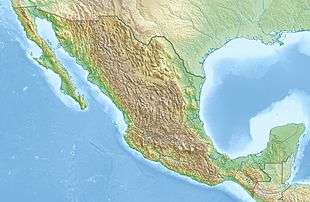1931 Oaxaca earthquake
 | |
| Date | January 15, 1931 |
|---|---|
| Magnitude | 8.0 Ms[1] |
| Depth | 40 km (25 mi) |
| Epicenter | 16°06′N 96°48′W / 16.1°N 96.8°WCoordinates: 16°06′N 96°48′W / 16.1°N 96.8°W |
| Type | Dip-slip |
| Areas affected | Mexico |
| Max. intensity | X (Extreme)[2] |
| Casualties | 114[3] |
The 1931 Oaxaca earthquake affected portions of southern Mexico on January 15, at 01:50 UTC. It registered a magnitude of 8.0 on the surface wave magnitude scale and had a maximum perceived intensity of X (Extreme) on the Mercalli intensity scale.[2]
Tectonic setting
The state of Oaxaca lies above the convergent boundary where the Cocos Plate is being subducted below the North American Plate at a rate of 6.4 cm/yr. The dip of the subducting slab is about 15° as defined by focal mechanisms and earthquake hypocenters. Seismicity in this area is characterised by regular megathrust earthquakes along the plate interface. In addition, there have been a series of historical normal fault events within the subducting slab. The area affected by moderate seismic intensities is about four times greater for the normal fault events compared to those on the plate interface and the peak horizontal acceleration is also higher in most cases.[4]
Earthquake
The earthquake is characterized as a normal fault event, and was the strongest in that area since the 1911 Michoacán earthquake. It caused no surface ruptures and did not generate a tsunami. From limited seismographic data, it is inferred to have had a focal depth of about 40 km. Analysis indicates that the rupture occurred deep down-dip within the subducted lithospheric slab, possibly breaking through the entire thickness of the slab.[1]
Damage
Early reporting from the Los Angeles Times described the city of Oaxaca as being in ruins.[5] 70 per cent of its buildings were either completely destroyed or badly damaged.[6] Messages were said to be fragmented coming over damaged communication systems as a result of telegraph lines having been knocked down. One message that did get through was from General Evaristo Perez, a military commander in the state of Oaxaca, to president Pascual Ortiz Rubio stating at least 25 persons were dead.[5] Veracruz and Tampico reported light damage and one death was reported in Mexico city.[5] The town of Miahuatlán de Porfirio Díaz, located between Oaxaca and the coast, was reported to be completely destroyed.[7]
Aftermath
Russian filmmaker Sergei Eisenstein, who was in Mexico working on a film, flew to Oaxaca shortly after the earthquake to film conditions in the affected area.[8] After having returned to Mexico City, Eisenstein reported on the deaths of 71 persons in Guelatova while attending a fiesta in a church there.[9] A total of 114 deaths were ultimately attributed to the earthquake.[3]
Many people abandoned the city of Oaxaca after the earthquake and low property prices meant that a small number of families were able to gain ownership of most of the city.[6] A magnitude 7.5 earthquake on September 30, 1999 had a hypocenter close to that of the 1931 earthquake.[10]
See also
References
- 1 2 Singh, S.K.; Suárez G. & Domínguez T. (5 December 1985). "The Oaxaca, Mexico, earthquake of 1931: lithospheric normal faulting in the subducted Cocos plate". Nature. 317: 56–58. Bibcode:1985Natur.317...56S. doi:10.1038/317056a0. Retrieved 29 December 2011.
- 1 2 National Geophysical Data Center. "Significant earthquake". U.S. National Oceanic and Atmospheric Administration. Retrieved 29 December 2011.
- 1 2 Historic World Earthquakes, U.S. Geological Survey Earthquake Hazards Program, retrieved 29 December 2011
- ↑ Singh, S.K.; M. Ordaz; L. Alcantara; N. Shapiro; V. Kostoglodov; J. F. Pacheco; S. Alcocer; C. Gutierrez; R. Quaas; T. Mikumo; E. Ovando; J. Aguirre; D. Almora; J. G. Anderson; M. Ayala; C. Javier; G. Castro; R. Duran; G. Espitia; J. Estrada; E. Guevara; J. Lermo; B. Lopez; O. Lopez; M. Macias; E. Mena; M. Ortega; C. Perez; J. Perez; M. Romo; M. Ramirez; C. Reyes; R. Ruiz; H. Sandoval; M. Torres; E. Vazquez; R. Vazquez; J. M. Velasco & J. Ylizaturri. "The Oaxaca earthquake of 30 September 1999 (MW = 7.5)" (PDF). Seismological Research Letters. 71 (1): 67–78. doi:10.1785/gssrl.71.1.67. Retrieved 30 December 2011.
- 1 2 3 "Quake Ruins Yield Dead; Report to Ortiz Rubio From Oaxaca Says at Least Twenty-five Mexicans Perished", Los Angeles Times, January 16, 1931
- 1 2 Murphy, A.D.; Stepick, A. (1991). Social inequality in Oaxaca: a history of resistance and change. Temple University Press. p. 39. ISBN 978-0-87722-868-4. Retrieved 30 December 2011.
- ↑ "Death Toll in Mexican Quake Rises; One Town Totally Wiped Out as Fatalities Mount to Known Total of 114", Los Angeles Times, January 19, 1931
- ↑ High, Peter B. (2005), A Mexican Tragedy: The Mutilation of a Cinematic Masterpiece (PDF), Graduate School of Languages and Cultures, Nagoya University, p. 97
- ↑ "Quake Makes Church Tomb; Seventy-one Worshipers Die in Mexican Disaster; Russian Film Producer Reports on Tragedy; Bodies in Oaxaca Cemetery Uncovered by Temblors", Los Angeles Times, January 18, 1931
- ↑ Kovach, Robert Louis (2004). Early earthquakes of the Americas. Cambridge University Press. pp. 47–48. ISBN 978-0-521-82489-7.
External links
- La destrucción de Oaxaca (video) – Short documentary film by Sergei Eisenstein depicts the aftermath of the 1931 earthquake